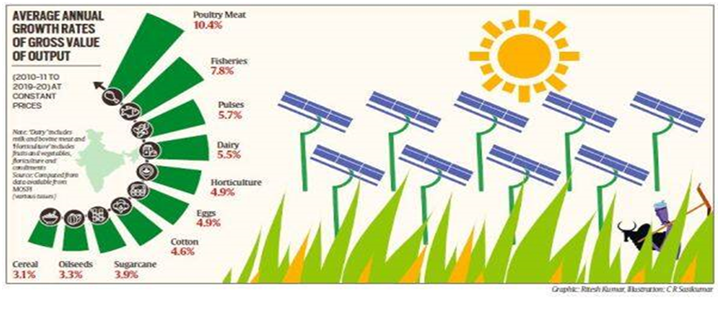Solar energy: For AmritKaal in agriculture (GS Paper 3, Environment)

Context:
- Recently, India celebrated 75 years of Independence and entered the AmritKaal toward 2047. The famous slogan of late Lal Bahadur Shastri, “Jai Jawan, Jai Kisan,” was extended by Atal Bihari Vajpayee to include “Jai Vigyan”. Now, Prime Minister Narendra Modi has extended it to, “Jai Anusandhan”.
- Let’s focus on Indian agriculture and see what farmers and agri-scientists have achieved in the last 75 years, and what more innovations (anusandhan) need to be made in the agri-food space by 2047 to have a well-fed India, with zero hunger, almost no malnutrition, climate resilience, and high incomes for farmers.
Challenges:
- When India became independent in 1947, its population was roughly 340 million, which has gone up by a little more than four times now, and is likely to surpass China by 2023. By 2050, the country’s population is likely to be 1.66 billion, as per the latest UN Population reports.
- So, the biggest challenge will be feeding a country whose per capita income still hovers around $2,300. The per capita income is likely to grow between 5 to 6 per cent per annum, under normal conditions.
- As they rise from low-income levels, people are likely to demand not just more food but safe and nutritious food.
- So, the first challenge would be to align agri-policies and strategies to the emerging demand pattern.
Emerging demand pattern:
- The infographic clearly shows that poultry and fisheries have the fastest growth, while it has been the slowest in cereal production. Government intervention is the most in cereals through the massive procurement of rice and wheat.
- While those sub-sectors that rely on market forces, no matter how imperfect, still perform better. The policy implication is very clear: Promote and get the markets right, which will help unleash revolutionary growth in agriculture.
Dimensions of the food system:
- But in the next 25 years, there is need to go beyond just increasing production. There is need to focus on the food system as a composite entity.
- It has five dimensions — production, marketing, and consumption are the traditional part of the food system, but two more must be added now.
- The environmental sustainability of our food systems and their nutritional outcomes are of utmost importance.
Climate-resilient agriculture:
- It is know from past experience that efforts to boost production and convert the country’s food situation from “ship to mouth” in the mid-1960s to emerging as the largest exporter of rice in the world (21mmt in FY22), have neglected the environmental consequences that have ensued.
- It is time to wake up now and promote climate-resilient agriculture. There is need to arrest the dramatic decline in groundwater table, particularly in the northwest, rejuvenate our soils, and improve the air quality by stopping/reducing stubble burning and methane emissions.
Innovations:
- There is need to develop carbon markets so that farmers can be incentivised to change existing farming practices that are not compatible with environmental sustainability.
- This requires innovations in policies, technologies related to precision farming as well as institutional engineering to include millions of smallholders, as seen in the case of the white (milk) revolution.
- The digitisation of agriculture can help in this. There is need to become a nation of innovators in agriculture like Israel, Holland, and the US.
Farmer’s income:
- However, making the agri-food system vibrant and competitive requires significantly augmenting farmers’ incomes. Against the backdrop of continuously declining average holding size from 2.3 hectares in 1970-71 to just 1.08 hectares in 2015-16, cereals cannot give high incomes to farmers even when their productivity is increased.
- Diversification toward high-value crops is a must. It will require building efficient value chains by the private sector. Policies need to create an ecosystem to promote this form of high-value agriculture and reduce the risks attached to it.
Solar as a third crop:
- But a few out-of-the-box innovations can almost double farmers’ incomes quickly. And one such innovation is to have “solar as a third crop” on fields. On one acre of cultivated land, which grows two crops a year, one can have more than 400 solar panels (trees) of 10 to 12 feet in height, with due spacing for regular cultivation to continue.
- Solar energy generated from 400 panels will be the “third crop” that can be bought by the power companies and incorporated into the grid for distribution.
- A pilot programme in the Najafgarh KVK area revealed that farmers could earn additional income of up to Rs one lakh/acre, when the capital cost is being incurred by another entrepreneur. This concept needs wider validation in different states with good sunshine.
- This is the “inclusive growth, green growth” model that needs to supplement the solar parks model being developed by big entrepreneurs.
Way Forward:
- In 2016, Prime Minister had given a clarion call to double farmers’ incomes by 2022-23. That can be done through a single innovation, provided he makes it a campaign and mobilises investors, farmers, renewable power companies, and discoms in that direction.
- PM Modi can use his social capital and powers of mobilisation, as witnessed recently in the “HarGharTiranga” campaign, for a “HarKhet Main Saur Urja” (solar power in every farmer’s field) project. If he does so, we can have clean energy in rural areas, and double and stabilise farmers’ incomes.


